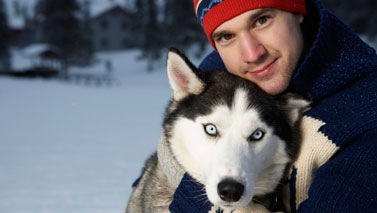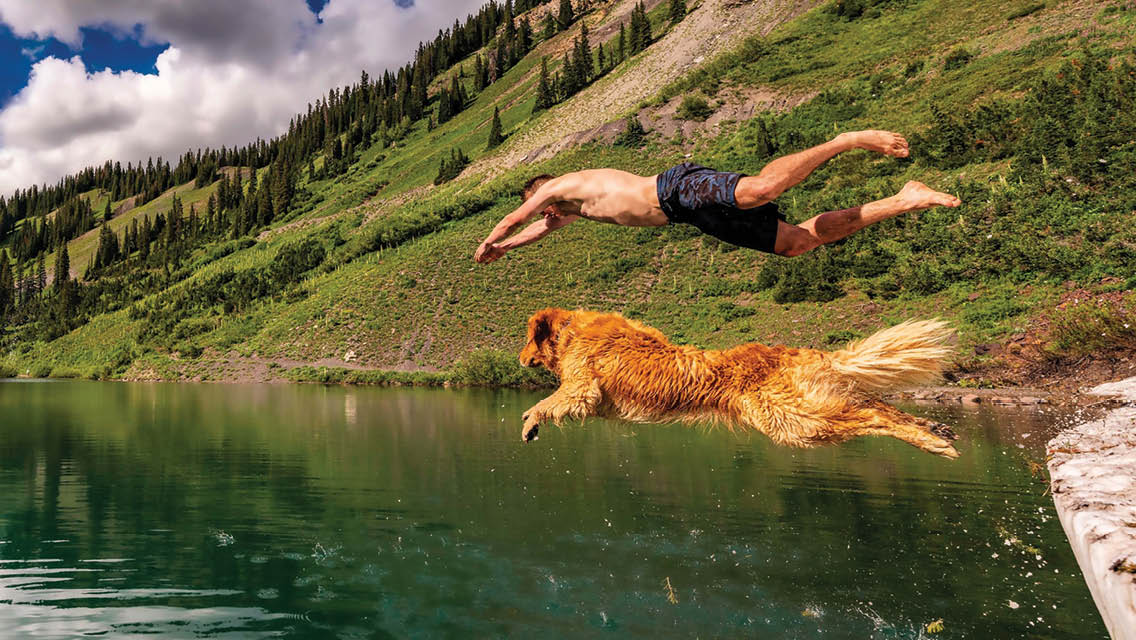In winter, Minnesota’s north woods are a study in extremes: extreme dark, especially on moonless evenings when trees blend together in a sort of hallucinogenic dance; extreme bright, as the sun glints off snow to create comet-like explosions of light; extreme cold, with late-January temps hovering around zero.
Even the quiet is extreme, the sort of pious silence that makes the snap of branches deafening and a whisper scream of sacrilege. That is, until the dogs get going.
“Good girl, Sitka! Good boy, Jax! Stay tight! Don’t let the males cross!”
Kathleen Anderson’s voice cuts through the din of the dog yard, offering encouragement to her team of sled dogs and barking orders to their temporary handlers to keep the leashes tight as we bring them to the gangline. Dogsledding has one rule: Never let go. Never let go of the sleds. Never let go of the dogs.
Anderson — a former social worker who created Wintermoon Summersun Adventures nearly 30 years ago in Brimson, Minn. — is the unequivocal leader of this pack of 36 Alaskan huskies, a mixed-breed line of northern dogs bred to pull, not show.
Sled dogs have been used for centuries across the northern reaches of North America, Europe, and Asia to transport trappers, haul freight, and deliver mail. The first written account of a sled-dog race was an informal challenge between travelers en route from Winnipeg to St. Paul, Minn., in the 1850s. By the 1930s, it was a full-fledged sport.
Recreational mushing emerged to maintain this tradition, and now sled rides, mushing lessons, and multiday treks are widely available for aspiring mushers like me.
Learning to Drive
Unlike most dogsledding teachers, Anderson doesn’t want to “just give people a ride.” She wants her students to “live the life of a musher,” she says. “I’ve lived rustic for 42 years. And you get to live rustic with me.”
Eight of us are here to live rustic with Anderson for four days as part of the annual Wild Women’s Dogsledding Adventure retreat she runs with wilderness guide Chris Heeter, founder of The Wild Institute. This year’s wannabe mushers hail from Arizona, California, Florida, and Minnesota and span over 30 years in age. At 32, I’m the youngest.
The retreat offers few luxuries and requires many responsibilities — primarily learning to care for Anderson’s pack of huskies, all of which brandish a kind of raw strength I’ve never encountered in household pets.
Overwhelmed by the noise, movement, and musky odor of the dog yard, I move with feigned confidence. A lifelong cat person, I want to meet the dogs where they are, with respect and not fear. I turn to “fake it till you make it” as a temporary mantra and try to act cool as I attempt to wrangle the sweet and playful Kesha, who bounds away each time I approach with her harness. As much as she wants to run — sled dogs love to run — she enjoys a few moments of taunting me.
Once Kesha notices that the other dogs are lined up, she assumes the position to be harnessed. Technically, I’m harnessing, leashing, and walking her to the sled, but in no way am I in charge. She’s allowing me to suit her up so she can do her favorite thing: drag a sled through the snowy woods.
The dogs on the ganglines are eager to begin; the clips, hooks, and metal brakes barely contain their energy. The dogs watching from the dog yard hoot and holler wildly.
I kneel onto the padded seat of the sled for the first dogsled ride of my life, noting Kesha among the three dogs ahead of me. It seems like a miracle that they haven’t ripped the sled from its anchors, and I tightly grip my hand holds.
Suddenly, we’re off. “Hike, hike,” calls DJ Erb, Anderson’s friend and musher. She came to Wintermoon Summersun 23 years ago as a gift to herself for her 30th birthday. She’s returned every year from upstate New York to help run the women’s retreat, paying forward an experience she says made her who she is today. “The dogs gave me my life back,” she says without elaboration.
“Hike, hike” is the command to go, but the dogs don’t need encouragement. They fly down the driveway, and I’m surprised when they heed Erb’s next command, “gee,” meaning “right.” Shifting my weight as instructed, I suddenly hear nothing. The dogs in the yard have quieted, and the dogs pulling have nothing to say. I hear only the whoosh of the sled and the sound of my breathing — ragged, though I’m doing none of the work.
Today is for observation. Tomorrow I’ll drive and assume responsibility for the sled, passenger, and, most importantly, the dogs. The gravity of the situation hits me.
“Haw!” I’m pulled back into the moment by Erb’s command, and I shift my weight again. “You OK?” she whispers in my ear once we round the turn, never once letting her hands off the sled.
I don’t know what I am, but it’s probably not OK. Seeing glimpses of the dogs’ wildness is mesmerizing and frightening. I feel wonderful and terrible, inspired and nauseated.
“Yes, I’m OK,” reminding myself to fake it till I make it, as we wind our way back to the dog yard.
Taking Charge
Day two means it’s my time to drive. Everyone except me seems excited. I still can’t shake my unease. But, not one to back down from a challenge, I step up to the sled and run my dogs. It takes every ounce of energy to hold on, stand upright, and speak commands. By the end of our short trip, I’m exhausted. My back, hands, and head ache. I’m shaking with the exertion of holding on and fear of what would happen if I let go.
“Nice job!” Erb says, giving me a high five and a hug. I receive similar accolades from the group. I was faking it pretty well, it seemed. But one thing was clear: I didn’t want to run again.
Later, during dinner, the other mushing students break bread and break open. Stories begin with, “I’ve never told anybody this” and end in tears.
Inexplicably, our group of strong, mostly type-A, hold-it-together-at-all-costs women are coming apart at the seams.
“I’m not this person,” says one of the women, wiping away tears. “I’m tough.”
“This is tough,” Heeter responds kindly. “This is a new level of tough.”
Anderson has found that spending time with the dogs can be transformative for women “who are many things to many people, but lose themselves and their wildness” in modern life.
Heading back to the guest house, I keep my fears to myself, letting my anxiety stew. I doze off with vague hopes that my dreams will deliver a dose of courage — and that I won’t have to use the outhouse in the middle of the night.
Finding Presence
I wake with the same feeling: I’m not driving today. I hate the thought of letting my fears get the best of me, and I shake off the “I don’t wannas.” I bundle up and step into the blue-pink predawn light, a sliver of a crescent moon still hanging in the sky.
Over breakfast, I finally share my hesitation.
“If you’re a little twitchy about the possibility that you might dump the sled, it’s OK,” says Erb. “It’ll keep you present. The lovely thing about this sport is that you have to be present. The dog is present for you, and you have to be present for you.”
Given our heightened emotions, we’re encouraged to spend time with the dogs. Each woman heads to one she’s connected with. I stand and watch. I haven’t built a rapport with any dog. I had created a story in my head that they couldn’t find something in me to love and I didn’t know how to love them. Overwhelmed, I begin to cry.
Finally, it’s time to run. We set off with me as passenger, assuming I’ll be ready to switch roles later. But looking ahead at the dogs and around at a group of similarly emotional women, my soundless tears transform into full-body sobs. As we pull out of the noisy yard into the quiet woods, I realize I don’t have any barking to drown out my cries. I can either pack what I’m feeling deep down inside me, or let it out and see what happens.
I let it out.
And what happens is eventually I’m able to drive.
The fear of failing the dogs doesn’t go away, but it takes a back seat as I work with them to control the sled. I keep a relaxed but firm grip on the handlebar; my chest is proud and upright; a slight bend in my knees helps me jump my hips from side to side to steer the sled.
It feels like flying. It feels like freedom.
List of Dogsledding Adventures
Wintermoon Wild Women’s Dogsledding Adventure
Brimson, Minn.
Jan. 26–29, 2017
$745 (includes meals, lodging, guides for four-day trip)
Juneau Glacier Dogsled Tour via Helicopter
Juneau, Alaska
Various dates
$510 (three-hour dogsled ride)
Ely, Minn.
Various dates
$975–$1,575 (includes meals, private lodging, and guides for three- or four-day trip)
Fairbanks, Alaska
Various dates
$50 (for a one-hour ride) to $950+ (for a three-day overnight Arctic trek)
Yellowstone Dog Sled Adventures
Big Sky, Mont.
Various dates
$235 (“Learn to Mush” half-day trip)




This Post Has 0 Comments